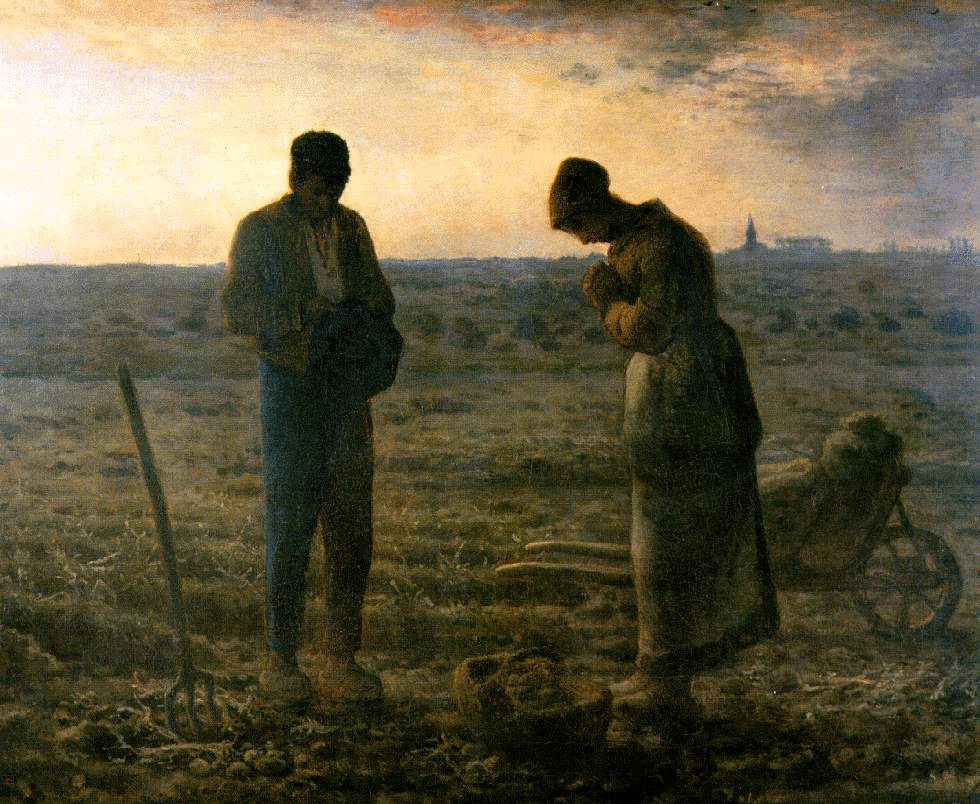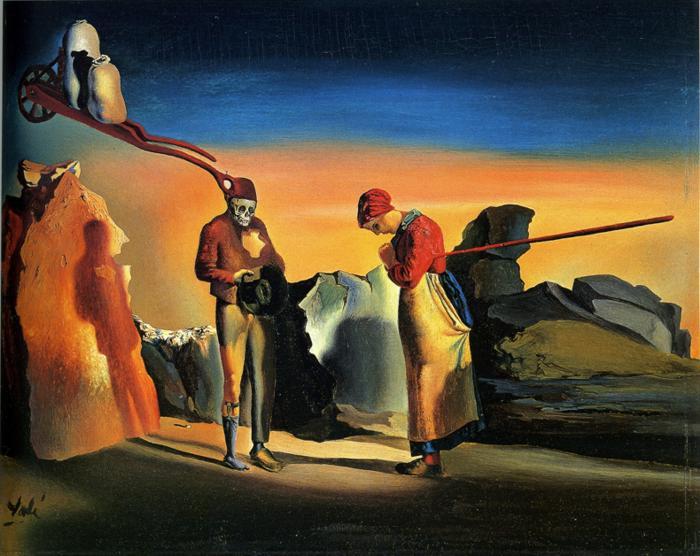Jean-François Millet - The Angelus, 1857 - 1859
Jean-François Millet (October 4, 1814 – January 20, 1875) was a French painter and one of the founders of the Barbizon school in rural France. Millet is noted for his scenes of peasant farmers; he can be categorized as part of the naturalism and realism movements.
The Angelus was reproduced frequently in the 19th and 20th centuries. Salvador Dalí was fascinated by this work, and wrote an analysis of it, The Tragic Myth of The Angelus of Millet. Rather than seeing it as a work of spiritual peace, Dalí believed it held messages of repressed sexual aggression. Dalí was also of the opinion that the two figures were praying over their buried child, rather than to the Angelus. Dalí was so insistent on this fact that eventually an X-ray was done of the canvas, confirming his suspicions: the painting contains a painted-over geometric shape strikingly similar to a coffin. However, it is unclear whether Millet changed his mind on the meaning of the painting, or even if the shape actually is a coffin.
http://en.wikipedia.org/wiki/Jean-Francois_Millet
Salvador Dalí - Angelus, ca.1932.
When talking about the great Catalonian painter, apart from the lion's head and the crab, a third animal motif can be linked to the vagina dentata, to the exciting theme of the “aggressive female sexuality and the devouring maternity”. The mantis, specially the female praying mantis that devours her male counterpart during the copulation represents the Kleinien concept of incorporation during the coitus fantasy. Dalí's related ideas are fully developed in his already mentioned The tragic myth of Millet's Angelus. While examining the couple of Millet's “maddening” work Dalí realized that the woman's stance perfectly corresponds to the female praying mantis' waiting attitude and the insect perfectly illustrates the tragic myth residing in Millet's Angelus. This myth is nothing else but what is felt like a man's (in our case Dalí's) inevitable fate, the annihilation by the motherly, female castrator during sexual intercourse. Dalí believed that he would suffer during a sexual intercourse the same way as a male praying mantis (Dalí, op.cit.). The image of the praying mantis implies the intertwining of eroticism and death, the theme of oral aggression, incorporation and cannibalism. As a looser association Dali mentioned that the mantis' stance could be compared to a kangaroo that was ready to attack and also that the symbol aided the emergence of mother-related fantasies, as the picture of this animal resembleed special and upsetting intra-uterine conditions (Dalí, op.cit.). At the same time, the image of the praying mantis leads to the circle of ideas related to the sacrum, hence becoming the bearer of what is called in George Bataille's Erotism the inseparable unity of erotism, death and the sacred (Bataille, 2000).
http://www.psyartjournal.com/article/show/kovry-the_enigma_of_desire_salvador_dal_and_th
Salvador Dalí - Archaeological Reminiscence of Millet's Angelus, 1933-35
Dalí’s principal theoretical contribution to
Surrealism was his ‘paranoiac–critical method’. First expounded in
his article ‘L’Ane pourri’ (1930), it was responsible for his
famous double images and essentially required the artist to perceive and
paint different images within a single collection of shapes. It
depended on an understanding of paranoia as an interpretative
delusion—a view shared with the psychoanalyst Jacques Lacan—and on
the virtuoso technique Dalí learnt from his study of the Old
Masters. The double images themselves had their roots in the
painting of Giuseppe Arcimboldo. The Endless Enigma offers six different interpretations
of one set of shapes: the realistic style blurs visual fact and
paranoiac fantasy.
http://www.moma.org/m/explore/collection/art_terms/1364/0/2.iphone_ajax?klass=artist
Salvador Dalí - The Railway Station at Perpignan, 1965





No comments:
Post a Comment